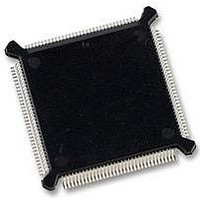MC68331CEH20 Freescale Semiconductor, MC68331CEH20 Datasheet - Page 41

MC68331CEH20
Manufacturer Part Number
MC68331CEH20
Description
IC MCU 32BIT 20MHZ 132-PQFP
Manufacturer
Freescale Semiconductor
Series
M683xxr
Specifications of MC68331CEH20
Core Processor
CPU32
Core Size
32-Bit
Speed
20MHz
Connectivity
EBI/EMI, SCI, SPI, UART/USART
Peripherals
POR, PWM, WDT
Number Of I /o
18
Program Memory Type
ROMless
Voltage - Supply (vcc/vdd)
4.5 V ~ 5.5 V
Oscillator Type
Internal
Operating Temperature
-40°C ~ 85°C
Package / Case
132-QFP
Controller Family/series
68K
No. Of I/o's
18
Cpu Speed
20MHz
No. Of Timers
1
Embedded Interface Type
QSPI, SCI, UART
No. Of Pwm Channels
2
Digital Ic Case Style
PQFP
Rohs Compliant
Yes
Processor Series
M683xx
Core
CPU32
Data Bus Width
32 bit
Data Ram Size
80 B
Interface Type
QSPI, SCI, UART
Maximum Clock Frequency
20 MHz
Number Of Programmable I/os
18
Number Of Timers
1
Maximum Operating Temperature
+ 85 C
Mounting Style
SMD/SMT
Minimum Operating Temperature
- 40 C
Cpu Family
68K/M683xx
Device Core
ColdFire
Device Core Size
32b
Frequency (max)
20MHz
Program Memory Size
Not Required
Total Internal Ram Size
80Byte
# I/os (max)
18
Number Of Timers - General Purpose
1
Instruction Set Architecture
RISC
Operating Temp Range
-40C to 85C
Operating Temperature Classification
Industrial
Mounting
Surface Mount
Pin Count
132
Package Type
PQFP
Lead Free Status / RoHS Status
Lead free / RoHS Compliant
Eeprom Size
-
Ram Size
-
Program Memory Size
-
Data Converters
-
Lead Free Status / Rohs Status
Details
Available stocks
Company
Part Number
Manufacturer
Quantity
Price
Company:
Part Number:
MC68331CEH20
Manufacturer:
Freescale Semiconductor
Quantity:
10 000
Part Number:
MC68331CEH20
Manufacturer:
FREESCLA
Quantity:
20 000
3.8.2 Interrupt Processing Summary
3.9 Factory Test Block
SIMTR — System Integration Module Test Register
SIMTRE — System Integration Module Test Register (E Clock)
TSTMSRA — Master Shift Register A
TSTMSRB — Master Shift Register B
TSTSC — Test Module Shift Count
TSTRC — Test Module Repetition Count
CREG — Test Module Control Register
DREG — Test Module Distributed Register
MC68331TS/D
service request has been detected and is pending.
A summary of the interrupt processing sequence follows. When the sequence begins, a valid interrupt
The test submodule supports scan-based testing of the various MCU modules. It is integrated into the
SIM to support production testing.
Test submodule registers are intended for Motorola use. Register names and addresses are provided
to indicate that these addresses are occupied.
A. The CPU finishes higher priority exception processing or reaches an instruction boundary.
B. Processor state is stacked. The contents of the status register and program counter are saved.
C. The interrupt acknowledge cycle begins:
D. Modules or external peripherals that have requested interrupt service decode the request level
E. After arbitration, the interrupt acknowledge cycle can be completed in one of three ways:
F. The vector number is converted to a vector address.
G. The content of the vector address is loaded into the PC, and the processor transfers control to
1. FC[2:0] are driven to %111 (CPU space) encoding.
2. The address bus is driven as follows. ADDR[23:20] = %1111; ADDR[19:16] = %1111,
3. Request priority level is latched into the IP field in the status register from the address bus.
in ADDR[3:1]. If the request level of at least one interrupting module or device is the same as
the value in ADDR[3:1], interrupt arbitration contention takes place. When there is no conten-
tion, the spurious interrupt monitor asserts BERR, and a spurious interrupt exception is pro-
cessed.
1. The dominant interrupt source supplies a vector number and DSACK signals appropriate
2. The AVEC signal is asserted (the signal can be asserted by the dominant interrupt source
3. The bus monitor asserts BERR and the CPU32 generates the spurious interrupt vector
the exception handler routine.
which indicates that the cycle is an interrupt acknowledge CPU space cycle; ADDR[15:4]
= %111111111111; ADDR[3:1] = the level of the interrupt request being acknowledged;
and ADDR0 = %1.
to the access. The CPU32 acquires the vector number.
or the pin can be tied low), and the CPU32 generates an autovector number corresponding
to interrupt priority.
number.
Freescale Semiconductor, Inc.
For More Information On This Product,
Go to: www.freescale.com
$YFFA3A
$YFFA02
$YFFA08
$YFFA30
$YFFA32
$YFFA34
$YFFA36
$YFFA38
41











